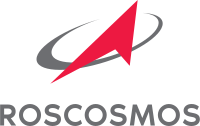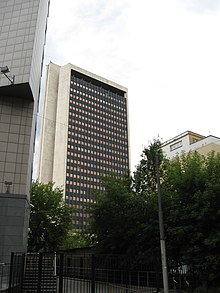
Back Roscosmos AN وكالة الفضاء الاتحادية الروسية Arabic Axencia Espacial Federal Rusa AST Rusiya Federal Kosmik Agentliyi Azerbaijani Roscosmos BCL Раскосмас Byelorussian Федерална космическа агенция Bulgarian রসকসমস Bengali/Bangla Ruska svemirska agencija BS Roscosmos Catalan
| Государственная корпорация по космической деятельности «Роскосмос» | |
 | |
 Headquarters in Moscow, Russia | |
| Agency overview | |
|---|---|
| Abbreviation | Roscosmos |
| Formed | 25 February 1992 (as the Russian Space Agency) |
| Preceding agency |
|
| Type | Space agency |
| Jurisdiction | Government of Russia |
| Headquarters | Moscow, Russia 55°47′2″N 37°37′50″E / 55.78389°N 37.63056°E |
| Official language | Russian |
| Yury Borisov[1] | |
| Primary spaceports | |
| Owner | Russia |
| Employees | 170,500 (2020) |
| Annual budget | |
| Website | roscosmos.ru (archived) |
The State Corporation for Space Activities "Roscosmos" (Russian: Государственная корпорация по космической деятельности «Роскосмос», romanized: Gosudarstvennaya korporatsiya po kosmicheskoy deyatel'nosti), commonly known simply as Roscosmos (Russian: Роскосмос), is a state corporation of the Russian Federation responsible for space flights, cosmonautics programs, and aerospace research.[3]
Originating from the Soviet space program founded in the 1950s, Roscosmos emerged following the dissolution of the Soviet Union in 1991. It initially began as the Russian Space Agency,[note 1] which was established on 25 February 1992[4] and restructured in 1999 and 2004 as the Russian Aviation and Space Agency[note 2] and the Federal Space Agency (Roscosmos),[note 3] respectively.[4] In 2015, the Federal Space Agency (Roscosmos) was merged with the United Rocket and Space Corporation, a government corporation, to re-nationalize the space industry of Russia, leading to Roscosmos in its current form.[5][6][7]
Roscosmos is headquartered in Moscow, with its main Mission Control Center in the nearby city of Korolyov, and the Yuri Gagarin Cosmonaut Training Center located in Star City in Moscow Oblast. Its launch facilities include Baikonur Cosmodrome in Kazakhstan, the world's first and largest spaceport, and Vostochny Cosmodrome, which is being built in the Russian Far East in Amur Oblast. Its director since July 2022 is Yury Borisov.[8]
As the main successor to the Soviet space program, Roscosmos' legacy includes the world's first satellite, the first human spaceflight, and the first space station (Salyut). Its current activities include the International Space Station, wherein it is a major partner. On 22 February 2019, Roscosmos announced the construction of its new headquarters in Moscow, the National Space Centre. Its Astronaut Corps is the first in the world's history.
- ^ "Roscosmos State Corporation for Space Activities - The Russian Government". Government of Russia. Retrieved 1 December 2023.
- ^ ""Роскосмосу" разрешили не возвращать в бюджет часть доходов". 2 October 2020. Archived from the original on 22 February 2022. Retrieved 22 February 2022.
- ^ Federation, International Astronautical. "IAF : ROSCOSMOS". www.iafastro.org. Archived from the original on 9 February 2022. Retrieved 9 February 2022.
- ^ a b "25 февраля 1992 года образовано Российское космическое агентство, в настоящее время – Федеральное космическое агентство (Роскосмос)". Archived from the original on 20 October 2020. Retrieved 10 August 2020.
- ^ "Путин подписал указ об упразднении Федерального космического агентства". 28 December 2015. Archived from the original on 23 February 2020. Retrieved 10 August 2020.
- ^ Avaneesh Pandey (28 December 2015). "Russia's Federal Space Agency Dissolved, Responsibilities To Be Transferred To State Corporation". International Business Times. Archived from the original on 8 September 2016. Retrieved 28 December 2015.
- ^ "Vladimir Putin abolishes Russian space agency Roscosmos". The Financial Express. 28 December 2015. Archived from the original on 1 January 2016.
- ^ "Dmitry Rogozin has been dismissed as director general of Roscosmos". 15 July 2022. Archived from the original on 18 July 2022. Retrieved 19 July 2022.
Cite error: There are <ref group=note> tags on this page, but the references will not show without a {{reflist|group=note}} template (see the help page).